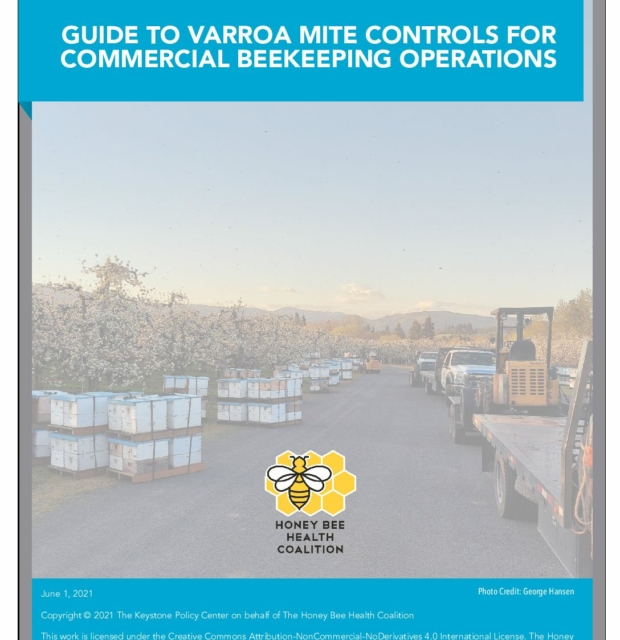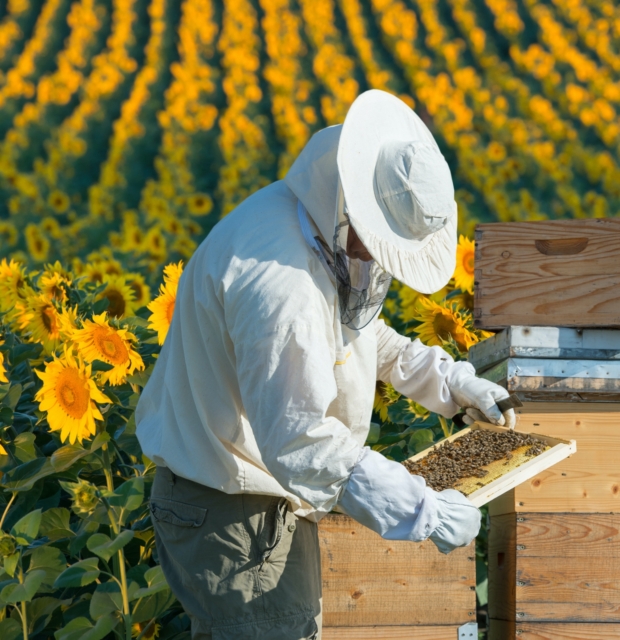News
Honey Bee Health Coalition Releases ‘Bee Healthy’ Roadmap to Improve Honey Bee Health
Roadmap Lays Out Comprehensive Approach to Tackling Top Four Issues Impacting Honey Bee Health
Keystone, Colorado, October 16, 2014 – The Honey Bee Health Coalition, a coalition of more than 30 organizations and agencies from across food, agriculture, government and conservation, today released Bee Healthy, a roadmap to improve honey bee health through collective action that will accomplish more than any one group can achieve on its own. Facing unacceptable declines in honey bee health, the Coalition’s Bee Healthy Roadmap lays out specific priorities and actions that it will take to reverse these declines and improve the health of honey bees and other pollinators. The Roadmap also provides a framework for ongoing collaboration inviting anyone with a vested interest in honey bee health to work together to achieve its vision of Healthy Honey Bees, Healthy People, Healthy Planet.
Coalition establishes science-based platform for cross-industry coordination on four priority areas
“The Bee Healthy Roadmap lays out a specific set of priorities through which the Coalition will achieve its core mission,” said Dennis vanEngelsdorp, Assistant Professor at the University of Maryland’s Department of Entomology and a member of the Coalition’s Steering Committee. “By collaboratively implementing solutions through partnerships across food, agriculture, government, and conservation partners,” he continued, “we can achieve a healthy population of honey bees and healthy populations of native and managed pollinators, productive agriculture systems, and thriving ecosystems.” The Coalition is committed to developing explicit goals, milestones and metrics to measure improvements in honey bee health. Knowing that the Coalition can’t improve honey bee health on its own, the Bee Healthy Roadmap identifies four priority areas that need immediate and consistent action from partners across the landscape. These include improving Hive Management, Forage & Nutrition, Crop Pest Management, and Cross-Industry Education, Outreach and Coordination. For each priority, the Bee Healthy Roadmap sets out specific actions the Coalition and its members will take and invites others to join forces or take steps on their own to improve pollinator health.
Improving honey bee health takes better management, technology, and innovation backed by science
Hive Management
“The Coalition is actively working to address major challenges to honey bee health, including poor nutrition and the need to protect bee health while controlling crop pests. One of the biggest threats is the Varroa destructor mite and even the best beekeepers could use help controlling it,” said George Hansen, Past President of the American Beekeeping Federation and a member of the Coalition’s Steering Committee and its Hive Management Working Group. “The Bee Healthy Roadmap invests in gathering and then transferring specific know-how and technologies to beekeepers to improve hive monitoring and training to control varroa mites and other pests and pathogens.” The Coalition also identified gaps in existing hive management research and will promote science-based innovations to close those gaps, including the development and registration of new products to address the varroa mite. In 2014 and 2015 the Coalition will help increase funding for “tech transfer teams” to go into the field and collect data and directly monitor bee health while also providing beekeepers with important information to inform management practices. The Coalition will also undertake the creation of a best practices guide for beekeepers for managing varroa mites.
Forage & Nutrition
“Bees, like most species, need a healthy, diverse habitat for their foraging diet,” said Peter Berthelsen, Director of Habitat Partnerships for Pheasants Forever, Inc., a member of the Coalition’s Steering Committee and Forage & Nutrition Working Group. “Which is why the Bee Healthy Roadmap focuses on building strategies to promote improved nutrition for honey bees through several important initiatives that can also benefit a broad range of other species’ foraging and habitat needs.” The Bee Healthy Roadmap calls for the development of high-quality, bee-friendly landscapes in places and seasons when bees can most use them — like flowers planted on transportation corridors or in and around farms, ranches and other production agriculture areas. Nutritional requirements vary from region to region, so the Coalition will begin this year by identifying strategies for meeting forage and nutrition needs in the agricultural lands of the American Upper Midwest and will later identify strategies in other regions of North America. The Coalition has also begun work to identify and promote the planting of bee-healthy forage along transportation corridors and rights-of-way and will continue to look at other opportunities for forage in private and public lands. The Coalition will also encourage the development of supplemental nutrition options for bees and the planting of bee-friendly cover crops. All of these solutions aim to create win-win solutions for bees, other species, agriculture producers, and other land owners.
Managing Crop Pests
“To feed a hungry planet we need to simultaneously manage agricultural pests while ensuring the health of bees and native pollinators,” said Gregory Sekulic, Agronomy Specialist at Canola Council of Canada and a member of the Coalition’s Crop Pest Management Working Group. “This Roadmap lays out plans for promoting crop- and product-specific pest management practices that enable us to do both.” To achieve this goal the Coalition will work to accelerate the adoption and use of the best known crop pest management practices, also known as Best Management Practices (BMPs). These BMPs include promoting and improving communication and coordination between beekeepers and producers to avoid honey bee losses, and also promoting better understanding and reporting of incidents of honey bee losses that impact bee health when they do occur.
Cross-Industry Collaboration
“The Coalition itself is a cross-sector collaborative platform and the success of our efforts depends on effective communication, outreach, and education across all stakeholders,” said Bill Kuckuck, Executive Vice President and Chief Operating Officer for CropLife America and a member of the Coalition’s Steering Committee and Outreach, Education and Communication Working Group. “That’s why the Bee Healthy Roadmap lays out specific plans for improving collaboration and communication throughout the food chain and with the general public.” The Coalition is building a set of tools to support its work and accelerate the adoption of best practices and technologies and will promote understanding across stakeholders.
In all of its efforts, the Coalition emphasizes the need for partners to join together in taking collective action that will achieve more than any one partner can accomplish on its own.
“The Coalition’s Bee Healthy Roadmap is very ambitious,” said The Keystone Center’s Julie Shapiro, the Coalition’s facilitator, “but by building off of the excellent collaboration among Coalition members to date, and with the help and support of new partners, we can achieve our goal of substantially improving honey bee health.”
To get involved in the Coalition or to learn how you can take action, please visit www.honeybeehealthcoalition.org.
About the Honey Bee Health Coalition
The Honey Bee Health Coalition brings together beekeepers, growers, researchers, government agencies, agribusinesses, conservation groups, manufacturers and brands, and other key partners to improve the health of honey bees and other pollinators. Our mission is to collaboratively implement solutions that will help to achieve a healthy population of honey bees while also supporting healthy populations of native and managed pollinators in the context of productive agricultural systems and thriving ecosystems. The Coalition is focusing on accelerating collective impact to improve honey bee health in four key areas: forage and nutrition, hive management, crop pest management, and communications, outreach and education.
Through its unique network of private and public sector members, the Coalition fosters new partnerships, leverages existing efforts and expertise, and incubates and implements new solutions. The Coalition brings its diverse resources to bear in promoting communication, coordination, collaboration, and investment to strategically and substantively improve honey bee health in North America.
Coalition members currently include Agricultural Retailers Association, Almond Board of California, American Beekeeping Federation, American Honey Producers Association, American Seed Trade Association, Bayer CropScience, Browning Honey Company, Canadian Honey Council, Canola Council of Canada, CropLife America, CropLife Canada, Ducks Unlimited, DuPont, Eastern Missouri Beekeepers Association, Land O’Lakes, Inc., Florida Fruit and Vegetable Association, Monsanto Company, Oregon State Beekeepers Association, National Association of State Departments of Agriculture, National Corn Growers Association, Pheasants Forever, Pollinator Stewardship Council, Project Apis m., Saint Louis Zoo’s WildCare Institute Center for Native Pollinator Conservation, Syngenta, Unilever, United Soybean Board, University of Maryland’s Department of Entomology, U.S. Canola Association, and Western Apicultural Society. The Coalition also includes ex officio participation from U.S. Department of Agriculture and U.S. Environmental Protection Agency.
About The Keystone Center
The Honey Bee Health Coalition is facilitated by The Keystone Center, an independent, non-profit organization specializing in collaborative decision-making processes for agriculture, environment, education, energy, and health policy issues.
###

